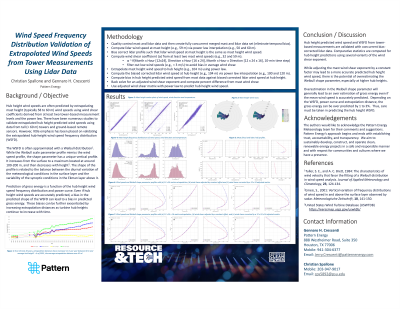Back

Wind Speed Frequency Distribution Validation of Extrapolated Wind Speeds from Tower Measurements Using Lidar Data
Tuesday, October 1, 2024
5:00 PM – 6:00 PM MST
Location: Regency D


Gennaro H. Crescenti
Lead Meteorologist
Pattern Energy
Houston, Texas
Poster Presenter(s)
Presentation Description: Hub height wind speeds are often predicted by extrapolating mast height (typically 60 m) wind speeds using wind shear coefficients derived from at least two tower-based measurement levels and the power law. The wind shear coefficient may be a constant which represents the long-term average, or a function of hour, month, direction, wind speed, or a combination of two or more of these independent variables. Over the years, there have been numerous studies to validate extrapolated hub height predicted wind speeds using data from tall (> 60 m) towers and ground-based remote sensors such as sodar and lidar. However, little emphasis has been placed on validating the extrapolated hub-height wind speed frequency distribution (WSFD).
The WSFD is often approximated using a Weibull regression which is specified by the scale (A) and shape (k) parameter. High values of the shape parameter imply a narrower WSFD while low values imply a broader WSFD. Contrary to the scale parameter which resembles the wind speed profile, the shape parameter has a very characteristic vertical profile. It increases from the surface to a maximum located at around 100–200 m, and then decreases with height. The shape of the profile is related to the balance between the diurnal variation of the meteorological conditions in the surface layer and the variability of the synoptic conditions in the Ekman layer above it.
Prediction of gross energy is a function of the hub height WSFD and power curve. Even if hub height wind speeds are accurately predicted, a bias in the predicted shape of the WSFD can lead to a bias in predicted gross energy. These biases can be further exacerbated by increasing extrapolation distances as turbine hub heights continue to increase with time.
The WSFD is often approximated using a Weibull regression which is specified by the scale (A) and shape (k) parameter. High values of the shape parameter imply a narrower WSFD while low values imply a broader WSFD. Contrary to the scale parameter which resembles the wind speed profile, the shape parameter has a very characteristic vertical profile. It increases from the surface to a maximum located at around 100–200 m, and then decreases with height. The shape of the profile is related to the balance between the diurnal variation of the meteorological conditions in the surface layer and the variability of the synoptic conditions in the Ekman layer above it.
Prediction of gross energy is a function of the hub height WSFD and power curve. Even if hub height wind speeds are accurately predicted, a bias in the predicted shape of the WSFD can lead to a bias in predicted gross energy. These biases can be further exacerbated by increasing extrapolation distances as turbine hub heights continue to increase with time.
